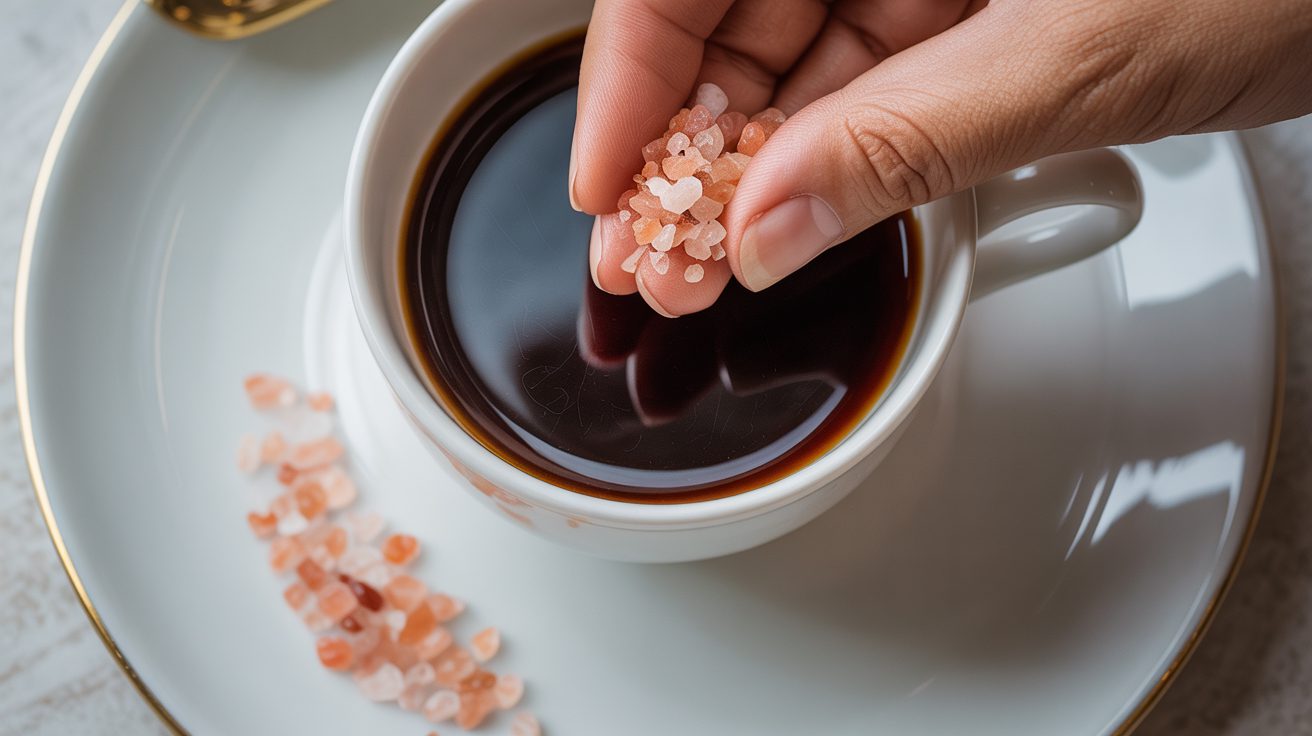Coffee Blog
The Pinch of Paradox: Why Salt is Coffee’s Unlikeliest Ally

In the ever-evolving world of coffee, where precision scales, temperature-controlled kettles, and single-origin beans reign supreme, a humble ingredient from the kitchen pantry is causing a stir. The trend of adding a pinch of salt to coffee, once a fringe piece of folk wisdom, is percolating into the mainstream. It sounds like a culinary contradiction—why would one add a mineral known for enhancing savoury dishes to a beloved bitter beverage? Yet, the science and tradition behind this practice reveal a fascinating story of flavour alchemy, cultural heritage, and a quest for the perfect cup.
The Science of Smoothness: What Salt Actually Does to Coffee
At its core, the effect of salt on coffee is a brilliant piece of chemical trickery. Coffee’s bitterness primarily comes from two compounds: caffeine and, more significantly, a class of phenolic antioxidants called chlorogenic acid lactones. Our tongues perceive bitterness through specific taste receptors, and salt—or more precisely, the sodium ions (Na+) in it—interferes with this process.
Salt doesn’t “remove” the bitterness; it masks it. The sodium ions suppress our ability to taste bitter compounds by blocking the same taste receptors they bind to. This doesn’t make the coffee less acidic (a measure of pH), but it makes it taste less acidic and harsh. By dialling down the bitterness, salt allows the other, more subtle flavours of the coffee to shine through. The inherent sweetness, the fruity notes, the chocolatey undertones—all become more pronounced when they’re not being shouted down by bitterness. The result is a cup that is perceived as remarkably smoother, rounder, and more balanced.
The Art of the Pinch: Method, Measurement, and Roast
This is not a practice of free-pouring from the shaker. The key is subtlety. A common recommendation is to start with a single, tiny pinch of fine-grained salt (about 1/16th of a teaspoon) for a full 6-8 ounce cup. You can add it directly to the coffee grounds before brewing, which allows for even distribution, or stir it into a freshly brewed cup. The pre-brewing method is often preferred as it integrates the salt more seamlessly.
The type of coffee does matter. This trick is most beneficial for cheaper, lower-quality, or over-extracted coffee that tends to be aggressively bitter. A dark roast, which is naturally more bitter due to the longer roasting process, is a prime candidate for a salt rescue mission. For a high-quality, lightly roasted single-origin coffee that already boasts complex, delicate flavours, adding salt might actually obscure its unique characteristics. It’s a tool for correction and enhancement, not a one-size-fits-all solution.
Beyond Taste: Aroma and Mouthfeel
While the primary effect is on taste, salt can have secondary impacts on aroma and texture. By reducing bitterness, it can subtly alter the perceived aroma, making the coffee smell “softer” and less sharp. As for texture, some aficionados report a very slight change in mouthfeel, describing the coffee as feeling “fuller” or “softer” on the palate. This isn’t as dramatic as the effect of cream, but it contributes to the overall impression of a smoother, more integrated beverage.
From Kitchen Counter to Café: The Professional Embrace
While still far from standard practice, the salt hack is gaining traction among baristas and adventurous cafés. Some are using it as a secret weapon to perfect their batch brew, especially when using blends that can have a bitter edge. More visibly, we’re seeing a rise in salted coffee drinks on menus. Salted caramel lattes have been a sweet-tooth staple for years, but now we’re seeing more nuanced applications: a pinch of salt in a classic Americano to enhance its clarity, or a delicate salted foam topping on a flat white. It’s a sign that the industry is recognizing salt not just as a flavour (salty), but as a flavour enhancer.
A Tradition with Deep Roots: The Historical and Cultural Origins
The idea of salting coffee is not a new, internet-born fad. Its origins are deeply cultural and surprisingly widespread.
-
Scandinavia & Northern Europe: In parts of Sweden, Finland, and Estonia, it was traditional to serve “salty coffee” (saltkaffe) to guests. The origin stories vary—some say it was a test of a suitor’s politeness, others a method to make cheap coffee more palatable, or even a way to ensure guests drank slowly and savoured the visit.
-
Turkey & the Middle East: In some Bedouin and Turkish coffee traditions, salt is sometimes added during the brewing process. In a fascinating practice, a bridegroom might be served extremely salty coffee at his wedding to… test his character, a theme that recurs in these traditions.
-
Navy & Military: Sailors, often stuck with stale coffee and hard water, used salt to counteract the bitterness and improve the taste of their brew. This practical application kept the knowledge alive in seafaring communities.
-
The American South: Alton Brown, the food scientist and TV personality, is often credited with popularizing the idea in the modern US. He famously advocated for adding a quarter-teaspoon of kosher salt to every six tablespoons of grounds to combat bitterness and improve flavour extraction.
The trend is resurfacing now because we are in a golden age of coffee curiosity. Home brewers and professionals alike are deconstructing every variable, from water mineral content to grind size. In this environment of experimentation, old “life hacks” are being rediscovered and validated by science.
The Biggest Misconception and Potential Downsides
The most significant misconception is that salted coffee will taste “salty.” When done correctly, it shouldn’t. The goal is not to make a savoury broth but to use salt as a background catalyst that rebalances the entire flavour profile. If you can taste the salt, you’ve used too much.
The primary downside is the risk of over-salting, which will indeed ruin your cup. Chemically, there’s no harm to the coffee itself. Taste-wise, as mentioned, it can blunt the desirable complexities of a high-end, lightly roasted coffee. It’s a tool best used with intention and a light touch.
The Health Perspective: Benefits and Cautions
From a health standpoint, the amount of salt we’re discussing—a tiny pinch—is negligible. It adds perhaps 50-100 mg of sodium to your drink, a fraction of the 2,300 mg daily limit recommended by most health authorities. For the vast majority of people, this is not a concern.
Could it offer electrolyte benefits? Theoretically, yes. Sodium is a key electrolyte, and if you’re drinking coffee after a workout and are dehydrated, a pinch of salt could provide a minuscule boost. However, the amount is so small that it’s not a reliable hydration strategy. For that, you’re better off with a dedicated electrolyte drink or, simply, food and water.
Nutritionally, adding a pinch of salt is a far better alternative than loading your coffee with sugar or cream. It adds virtually no calories, no fat, and no carbohydrates, making it an excellent option for those managing their weight or blood sugar.
Who should avoid it? Individuals on strict, doctor-advised, low-sodium diets (such as those with heart failure or severe hypertension) should likely skip this trend, as every milligram of sodium counts for them. For everyone else, it’s a safe and potentially rewarding experiment.
In the end, the salt-in-coffee trend is a beautiful reminder that the pursuit of a better cup is both a science and an art. It connects us to generations past who, without mass spectrometers, understood the balancing power of this simple mineral. So, the next time you brew a pot that’s a little too harsh, don’t reach for the sugar first. Try a pinch of salt. You might just find that the secret to a smoother, sweeter-tasting coffee has been in your kitchen all along.



 Bee Mugs
Bee Mugs Bird Mugs
Bird Mugs Bunny Mugs
Bunny Mugs Cat Mugs
Cat Mugs Goat Mugs
Goat Mugs Horse Mugs
Horse Mugs Lion Mugs
Lion Mugs Monkey Mugs
Monkey Mugs Moose Mugs
Moose Mugs Owl Mugs
Owl Mugs Sheep Mugs
Sheep Mugs Snail Mugs
Snail Mugs Turtle Mugs
Turtle Mugs Unicorn Mugs
Unicorn Mugs
 Engagement Mugs
Engagement Mugs Retirement Mugs
Retirement Mugs St Patrick’s Day Mugs
St Patrick’s Day Mugs Thank You Mugs
Thank You Mugs
 Boss Mugs
Boss Mugs Christmas Mugs
Christmas Mugs Colleague Mugs
Colleague Mugs Dad Mugs
Dad Mugs Grandad Mugs
Grandad Mugs Grandma Mugs
Grandma Mugs Husband Mugs
Husband Mugs Lawyer Mugs
Lawyer Mugs Nurse Mugs
Nurse Mugs Sarcastic Mugs
Sarcastic Mugs Uncle Mugs
Uncle Mugs Wife Mugs
Wife Mugs
 Fourth of July Mugs
Fourth of July Mugs Halloween Mugs
Halloween Mugs Thanksgiving Mugs
Thanksgiving Mugs Valentines Day Mugs
Valentines Day Mugs
 Amsterdam Mugs
Amsterdam Mugs Barcelona Mugs
Barcelona Mugs Berlin Mugs
Berlin Mugs Chicago Mugs
Chicago Mugs Dubai Mugs
Dubai Mugs London Mugs
London Mugs Paris Mugs
Paris Mugs Rome Mugs
Rome Mugs Sydney Mugs
Sydney Mugs Tokyo Mugs
Tokyo Mugs Toronto Mugs
Toronto Mugs
 Aunt Mugs
Aunt Mugs Boss Mugs
Boss Mugs Boyfriend Mugs
Boyfriend Mugs Co-Worker Mugs
Co-Worker Mugs Couples Mugs
Couples Mugs Gamer Mugs
Gamer Mugs Girlfriend Mugs
Girlfriend Mugs Nanny Mugs
Nanny Mugs Sister Mugs
Sister Mugs Teachers Mug
Teachers Mug
 Baseball Mugs
Baseball Mugs Fishing Mugs
Fishing Mugs Football Mugs
Football Mugs Golf Mugs
Golf Mugs Rugby Mugs
Rugby Mugs Soccer Mugs
Soccer Mugs Tennis Mugs
Tennis Mugs
 Best Man Mugs
Best Man Mugs Bridesmaids Mugs
Bridesmaids Mugs Father of the Bride Mugs
Father of the Bride Mugs Groomsmen Mugs
Groomsmen Mugs Matron of Honor Mugs
Matron of Honor Mugs
 Inspirational Mugs
Inspirational Mugs Offensive Mugs
Offensive Mugs Sexy Mugs
Sexy Mugs